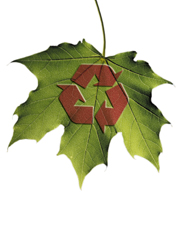
In his novel "1984," George Orwell outlined a rather grim future for the human race. Fortunately for us, it was only a work of fiction. However, something did happen that year that would forever change the world and, in particular, an industry.
North of the border, in the western Canadian province of British Columbia, the Greater Vancouver Regional District stopped accepting construction and demolition waste at its municipal landfills. No one knew it at the time, but this action would lead to the creation of an entirely new industry: gypsum recovery and recycling.
The Vancouver government took this action as a result of scientific studies that discovered that gypsum-board waste buried in landfills in high-rainfall areas (like British Columbia) were producing noxious hydrogensulfide (H2S) gas. Dangerous to humans at levels of greater than 1,000 parts per million, with a distinct odor akin to rotten eggs, one landfill was found to have H2S gas levels in excess of 5,000 PPM. H2S gas is produced when buried gypsum (calcium sulfate) waste combines with anaerobic bacteria and organic matter, and, with high moisture levels present, sulfate ions are released. The study revealed that H2S gas levels peaked between six and 15 years after burial in the landfill. Besides gypsum-board waste, other construction debris such as metal were emitting toxic leachates.
As a result of this ban on the dumping of construction waste in municipal landfills in the province, construction waste was now being transported by barge to an ocean dumping site 90 miles off the coast of Vancouver Island. Eventually, this practice was also banned, making disposal of construction waste a serious, ongoing problem for gypsum-wallboard manufacturers and local contractors.
Waste not, want not
It was a common belief among gypsum wallboard manufacturers for many years that gypsum wallboard production waste could not be recycled. Many attempts were made to recycle their own waste gypsum, but a process whereby the paper faces and edging could be completely removed and the recycled gypsum core ground and mixed with virgin gypsum to produce new gypsum wallboard was never perfected. If the paper faces and edging (which compose 12 percent by weight of the finished gypsum board panel) are not completely removed, the gypsum core will be contaminated by the residual paper in the recycled gypsum. Also, gypsum waste from the manufacturing process has a very high moisture content.Besides the gypsum waste produced by the manufacturing process (12 percent), new construction accounts for 64 percent, renovation 10 percent and demolition 14 percent of the total gypsum waste stream. In North America, gypsum waste accounts for a full 1 percent of the total waste stream. As a percentage of total construction and demolition waste, gypsum wallboard accounts for 15 percent. These are very significant quantities. The general rule of thumb for the industry is 1 pound of gypsum board waste is generated for every square foot of floor area. Translated, this is about 1 ton of gypsum board waste for the average size house.
Generally speaking, gypsum is an inert, naturally occurring mineral. However, under the right conditions it can become a biohazard, as witnessed by the study of landfills in British Columbia. Besides its primary use in wallboard production, gypsum can also be used as a soil additive, animal bedding or as a livestock feed, but recycled gypsum poses a serious risk if used for these purposes. From the gypsum wallboard manufacturing process, there are to be found traces of dioxins and furons in the paper faces and edging. Other contaminants, as well as high pH levels, are also present. For the various grades and types of gypsum board panels, a variety of additives are used, including soaps, boric acid, silicon glue, starches, potassium sulfate, fiber glass, chelating agents, water dispersants and asphalt wax emulsions.
Categorically speaking
Considering the fact that 18 billion tons of gypsum wallboard are produced every year in North America, recycling both production and construction gypsum waste can and does have a profound effect on the environment and, in turn, the construction industry. Although construction and demolition waste is generally considered an individual or single waste stream, it is actually comprised of five categories:1. Roadwork material: asphalt, concrete, earth fill, etc.
2. Excavated material: earth, sand, stones, etc.
3. Building demolition material: mixed rubble, concrete, steel, brick, timber, etc.
4. Construction and renovation material: wood, roofing, fixtures, gypsum wallboard, insulation, ductwork, pipe, carpet, etc.
5. Site clearance: trees, brush, earth, concrete, etc.
Gypsum wallboard construction and demolition waste occurs primarily in category 4, but also in category 3.
Before the advent of gypsum recycling, gypsum wallboard manufacturers transported 3 to 5 percent of their total production output as waste to landfills. On site, contractors would (and still do) cut and stack waste gypsum wallboard in non-insulated wall cavities, particularly chase walls. This is a dubious practice, both inefficient and risky.
Due to the landfill and the ban on ocean dumping, along with high tipping fees, recycled gypsum has proved to be very successful in British Columbia and other Canadian provinces. In the United States, the process still competes with landfills, but the initiative to ban construction debris and waste in landfills is gaining ground in many states and it is inevitable that recycled gypsum will be the rule rather than the exception in the near future.
Next month we'll take a look at the process of recycling gypsum and a company that made it possible, through innovative technology, the power of an idea and one man's vision for an industry and the future.

Report Abusive Comment